Human teeth have substantial overlap in shape and position in relation to gender. In one study, the general public and even dental professionals had a worse-than-chance record for identifying the assigned sex of human teeth from photographs.
In many places, cultural norms identify stereotypically “masculine” and “feminine” teeth.
Teeth basics
Most human children have 20 teeth. Most adult humans have 32 teeth.
The crown is the hard white surface of teeth that sticks out of the gums. It’s also the name of the prosthetic added to a damaged tooth. The midline of teeth is between the two front teeth. Humans typically have two rows of teeth:
- maxillary (upper teeth)
- mandibular (lower teeth)
Humans typically have four kinds of teeth on top and bottom, from front to back:
- incisors (8 front teeth used for biting or cutting)
- canines (4 pointy teeth that look like dog teeth)
- premolars (8 teeth behind the canines but before the molars)
- molars (12 flat teeth in the back used for chewing. The 4 farthest back are your third molars or wisdom teeth and usually emerge between age 17 and 21)
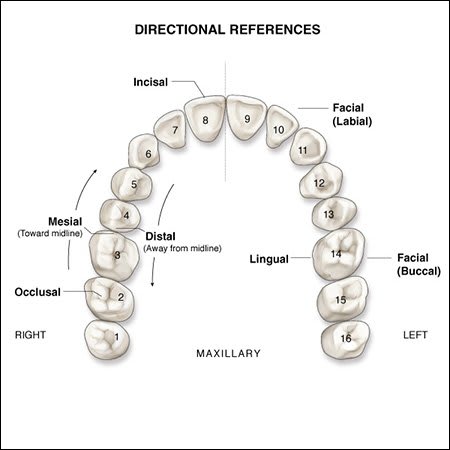
Source: dentalcare.com
According to the Universal Numbering System, teeth are numbered 1 through 32. #1 is the maxillary right third molar (the wisdom tooth furthest back on your upper right side). Teeth are then counted along the top row to #16. #17 is directly below #16 on the lower left. #32 and #1 make contact when you bite down.
- distal (surface away from the midline – the side facing your tongue)
- facial (side facing your lips – labial or cheeks – buccal)
- incisal (biting edge of a front tooth)
- lingual (side facing your tongue)
- mesial (surface closer to the midline – the side you see when you smile)
- occlusal (flat chewing surface of back teeth)
- proximal (surfaces that are next to each other)
Scientists measure the crowns of teeth in several ways:
- mesiodistal (width)
- cervico-occlusal (height)
- buccolingual (thickness)
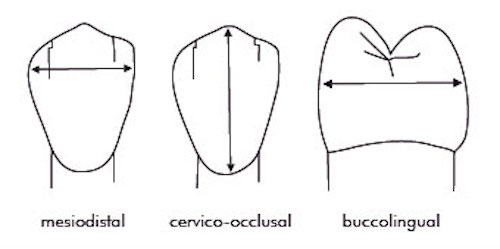
“On average, males possess larger tooth crowns than females in contemporary human populations” (Schwartz 2005).
“The most contributory measurements to the function were upper first incisor mesiobuccal–distolingual (MBDL) and distobuccal–mesiolingual, lower second incisor MBDL, and lower canine MBDL. The highest reliability was obtained in MBDL measurements. It was realized that diagonal measurements of teeth, especially of canines, revealed clear dimorphic differences. Classification accuracy was found to be 83.3% for total sample, 78.3 for upper jaw, and 85.0% for the lower jaw” (Karaman 2006).
In a 2012 study by Radlanski that asked participants to choose male, female, or question mark, these were the most correctly assessed masculine teeth:
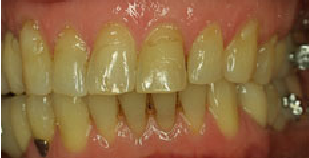
Correct assessment 71%, incorrect 23%, and question mark 6%. Source
These were the most correctly assessed feminine teeth:
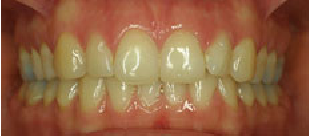
Correct assessment 76%, incorrect 14%, and question mark 10%. Source
Retired plastic surgeon and dentist Douglas Ousterhout noted that while teeth are generally similar, men’s and women’s chins tend to differ in terms of pointiness.
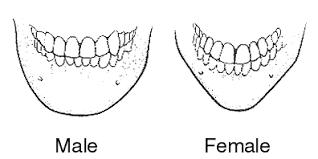
Clinical considerations
Trans people have reported discrimination in dental offices. The American Dental Association has information for members on Avoiding Gender Identity Discrimination In Your Office. Their Code of Professional Conduct also governs patient selection:
While dentists, in serving the public, may exercise reasonable discretion in selecting patients for their practices, dentists shall not refuse to accept patients into their practice or deny dental service to patients because of the patient’s race, creed, color, gender, sexual orientation, gender identity, national origin or disability.
If you feel you have been treated disrespectfully or discriminated against, let the owner or manager know of your concerns. If they do not address them, you can report your experiences on consumer review sites like Yelp, to the Better Business Bureau, and to various professional organizations. Depending on where you live, this may also be illegal.
Trans endodontist Anne L. Koch has noted the following dental considerations.
Trans men:
- Increased susceptibility to plaque, gingivitis, and periodontal disease
- Xerostomia – caries, periodontal disease
- Use of tobacco (decreased sense of taste)
- Cosmetic: square/less rounded teeth via recontouring or veneers
Trans women
- Estrogen may affect TMJ issues
- Estrogen + progesterone can lead to increased plaque sensitivity and gingivitis
- Cosmetic: more rounded teeth with less wear on incisal edges. Reduce philtrum length to show more lip and teeth.
Observed gender differences
Large and square incisors tend to be seen as “masculine.” Smaller and rounder incisors tend to be seen as “feminine.”
Canines tend to be larger and sharper in men, smaller and rounder in women.
European teeth may have more dimorphism than Asian or South American teeth (Zorba 2011).
As we age, all people tend to show their lower front teeth more. One study found a significant decrease in how much we show our upper teeth as we age, especially for men (Drummond 2016). This is why many trans people with some kinds of dental dysphoria can benefit from a philtrum reduction or Z-plasty.
References
Litha, Girish HC, Murgod S, Savita JK (2017). Gender determination by odontometric method. J Forensic Dent Sci. 2017 Jan-Apr;9(1):44. https://doi.org/10.4103/jfo.jfds_96_15
Radlanski RJ, Renz H, Hopfenmüller W (2012). Sexual dimorphism in teeth? Clinical relevance. Clin Oral Investig. 2012 Apr;16(2):395-9. https://doi.org/10.1007/s00784-011-0537-8 Epub 2011 Mar 10.
Brunetto J, Becker MM, Volpato CA (2011). Gender differences in the form of maxillary central incisors analyzed using AutoCAD software. J Prosthet Dent. 2011 Aug;106(2):95-101. https://doi.org/10.1016/S0022-3913(11)60102-9
Zorba E, Moraitis K, Manolis SK (2011). Sexual dimorphism in permanent teeth of modern Greeks.Forensic Sci Int. 2011 Jul 15;210(1-3):74-81. https://doi.org/10.1016/j.forsciint.2011.02.001. Epub 2011 Mar 2 .
Antoszewski B, Zadzińska E, Foczpański J (2009). The metric features of teeth in female-to-male transsexuals. Archives of Sexual Behavior. 2009 Jun;38(3):351-8. https://doi.org/10.1007/s10508-008-9315-3. Epub 2008 Feb 15.
Scwartz G, Dean MC (2005). Sexual dimorphism in modern human permanent teeth. American Journal of Physical Anthropology. Epub: 28 April 2005 https://doi.org/10.1002/ajpa.20211
Nishimura BJ (2017). Treatment Considerations for a Full-Mouth Reconstruction of a Transgender Patient. Compend Contin Educ Dent. 2017 Sep;38(8):544-551.
Heravi F, Rashed R, Abachizadeh H (2011). Esthetic preferences for the shape of anterior teeth in a posed smile. Am J Orthod Dentofacial Orthop. 2011 Jun;139(6):806-14. https://doi.org/10.1016/j.ajodo.2009.07.029
Drummond S, Capelli J Jr (2016). Incisor display during speech and smile: Age and gender correlations. Angle Orthod. 2016 Jul;86(4):631-7. https://doi.org/10.2319/042515-284.1 Epub 2015 Nov